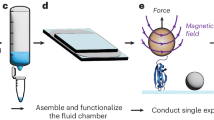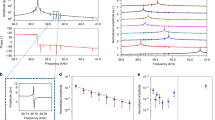Abstract
Nanoelectromechanical systems (NEMS) resonators can detect mass with exceptional sensitivity. Previously, mass spectra from several hundred adsorption events were assembled in NEMS-based mass spectrometry using statistical analysis. Here, we report the first realization of single-molecule NEMS-based mass spectrometry in real time. As each molecule in the sample adsorbs on the resonator, its mass and position of adsorption are determined by continuously tracking two driven vibrational modes of the device. We demonstrate the potential of multimode NEMS-based mass spectrometry by analysing IgM antibody complexes in real time. NEMS-based mass spectrometry is a unique and promising new form of mass spectrometry: it can resolve neutral species, provide a resolving power that increases markedly for very large masses, and allow the acquisition of spectra, molecule-by-molecule, in real time.
This is a preview of subscription content, access via your institution
Access options
Subscribe to this journal
Receive 12 print issues and online access
$259.00 per year
only $21.58 per issue
Buy this article
- Purchase on Springer Link
- Instant access to full article PDF
Prices may be subject to local taxes which are calculated during checkout





Similar content being viewed by others
References
Andersson, C-O. Mass spectrometric studies on amino acid and peptide derivatives. Acta Chem. Scand. 12, 1353 (1958).
Beynon, J. H. The use of the mass spectrometer for the identification of organic compounds. Microchim. Acta 44, 437–453 (1956).
Domon, B. & Aebersold, R. Mass spectrometry and protein analysis. Science 312, 212–217 (2006).
Benesch, J. L. P. & Robinson, C. V. Mass spectrometry of macromolecular assemblies: preservation and dissociation. Curr. Opin. Struct. Biol. 16, 245–251 (2006).
Robinson, C. V., Benesch, J. L. P., Ruotolo, B. T. & Simmons, D. A. Protein complexes in the gas phase: technology for structural genomics and proteomics. Chem. Rev. 107, 3544–3567 (2007).
Warscheid, B., Oeljeklaus, S. & Meyer, H. E. New dimensions in the study of protein complexes using quantitative mass spectrometry. FEBS Lett. 583, 1674–1683 (2009).
Van Duijn, E., Barendregt, A., Synowsky, S., Versluis, C. & Heck, A. J. R. Chaperonin complexes monitored by ion mobility mass spectrometry. J. Am. Chem. Soc. 131, 1452–1459 (2009).
Heck, A. J. R. Native mass spectrometry: a bridge between interactomics and structural biology. Nature Methods 5, 927–933 (2008).
Ekinci, K. L., Huang, X. M. H. & Roukes, M. L. Ultrasensitive nanoelectromechanical mass detection. Appl. Phys. Lett. 84, 4469–4471 (2004).
Ilic, B. et al. Attogram detection using nanoelectromechanical oscillators. J. Appl. Phys. 95, 3694–3703 (2004).
Yang, Y. T., Callegari, C., Feng, X. L., Ekinci, K. L. & Roukes, M. L. Zeptogram-scale nanomechanical mass sensing. Nano Lett. 6, 583–586 (2006).
Li, M., Tang, H. X. & Roukes, M. L. Ultra-sensitive NEMS-based cantilevers for sensing, scanned probe and very high-frequency applications. Nature Nanotech. 2, 114–120 (2007).
Chiu, H-Y., Hung, P., Postma, H. W. C. & Bockrath, M. Atomic-scale mass sensing using carbon nanotube resonators. Nano Lett. 8, 4342–4346 (2008).
Lassagne, B., Garcia-Sanchez, D., Aguasca, A. & Bachtold, A. Ultrasensitive mass sensing with a nanotube electromechanical resonator. Nano Lett. 8, 3735–3738 (2008).
Jensen, K., Kim, K. & Zettl, A. An atomic-resolution nanomechanical mass sensor. Nature Nanotech. 3, 533–537 (2008).
Naik, A. K., Hanay, M. S., Hiebert, W. K., Feng, X. L. & Roukes, M. L. Towards single-molecule nanomechanical mass spectrometry. Nature Nanotech. 4, 445–450 (2009).
Gil-Santos, E. et al. Nanomechanical mass sensing and stiffness spectrometry based on two-dimensional vibrations of resonant nanowires. Nature Nanotech. 5, 641–645 (2010).
Ekinci, K. L., Yang, Y. T. & Roukes, M. L. Ultimate limits to inertial mass sensing based upon nanoelectromechanical systems. J. Appl. Phys. 95, 2682–2689 (2004).
Siuzdak, G. The Expanding Role of Mass Spectrometry in Biotechnology (MCC Press, 2003).
Hanay, M. S. Towards Single-Molecule Nanomechanical Mass Spectrometry PhD thesis, California Insitute of Technology (2011).
Roukes, M. L., Naik, A. K. & Hanay, M. S. Single molecule mass spectroscopy enabled by nanoelectromechnical systems. US patent 8,227,747 (2012).
Dohn, S., Sandberg, R., Svendsen, W. & Boisen, A. Enhanced functionality of cantilever based mass sensors using higher modes. Appl. Phys. Lett. 86, 233501 (2005).
Dohn, S., Svendsen, W., Boisen, A. & Hansen, O. Mass and position determination of attached particles on cantilever based mass sensors. Rev. Sci. Instrum. 78, 103303 (2007).
Schmid, S., Dohn, S. & Boisen, A. Real-time particle mass spectrometry based on resonant micro strings. Sensors 10, 8092–8100 (2010).
Allan, D. W. Statistics of atomic frequency standards. Proc. IEEE 54, 221–230 (1966).
Casella, G. & Berger, R. L. Statistical Inference 2nd edn (Duxbury Press, 2001).
Bargatin, I., Kozinsky, I. & Roukes, M. L. Efficient electrothermal actuation of multiple modes of high-frequency nanoelectromechanical resonators. Appl. Phys. Lett. 90, 093116 (2007).
Mile, E. et al. In-plane nanoelectromechanical resonators based on silicon nanowire piezoresistive detection. Nanotechnology 21, 165504 (2010).
Caltech/CEA-LETI Alliance for Nanosystems VLSI, 200 mm (second generation) Standard NEMS process: ‘CAL2′; available at http://www.nanovlsi.com.
Kharrat, C., Colinet, E. & Voda, A. in Sensors, 2008 IEE Conference 1135–1138 (IEEE, 2008).
Chiang, C. L., Hsu, M. B. & Lai, L. B. Control of nucleation and growth of gold nanoparticles in AOT/Span80/isooctane mixed reverse micelles. J. Solid State Chem. 177, 3891–3895 (2004).
Kim, B., Carignano, M. A., Tripp, S. L. & Wei, A. Cluster size analysis of two-dimensional order in colloidal gold nanoparticle arrays. Langmuir 20, 9360–9365 (2004).
Westcott, S. L., Oldenburg, S. J., Lee, T. R. & Halas, N. J. Formation and adsorption of clusters of gold nanoparticles onto functionalized silica nanoparticle surfaces. Langmuir 14, 5396–5401 (1998).
Tanaka, K. The origin of macromolecule ionization by laser irradiation (Nobel Lecture). Angew. Chem. Int. Ed. 42, 3860–3870 (2003).
Hughey, C. T., Brewer, J. W., Colosia, A. D., Rosse, W. F. & Corley, R. B. Production of IgM hexamers by normal and autoimmune B cells: implications for the physiologic role of hexameric IgM. J. Immunol. 161, 4091–4097 (1998).
Collins, C., Tsui, F. W. L. & Shulman, M. J. Differential activation of human and guinea pig complement by pentameric and hexameric IgM. Eur. J. Immunol. 32, 1802–1810 (2002).
Azuma, Y. et al. Recombinant human hexamer-dominant IgM monoclonal antibody to ganglioside GM3 for treatment of melanoma. Clin. Cancer Res. 13, 2745–2750 (2007).
Lindhagen-Persson, M., Brännström, K., Vestling, M., Steinitz, M. & Olofsson, A. Amyloid-β oligomer specificity mediated by the IgM isotype—implications for a specific protective mechanism exerted by endogenous auto-antibodies. PLoS ONE 5, 13928 (2010).
Davis, A. C. & Shulman, M. J. IgM—molecular requirements for its assembly and function. Immunol. Today 10, 118–128 (1989).
Bacher, G. et al. Charge-reduced nano electrospray ionization combined with differential mobility analysis of peptides, proteins, glycoproteins, noncovalent protein complexes and viruses. J. Mass Spectrom. 36, 1038–1052 (2001).
Loo, J. A. et al. Electrospray ionization mass spectrometry and ion mobility analysis of the 20S proteasome complex. J. Am. Soc. Mass. Spectrom. 16, 998–1008 (2005).
Acknowledgements
The authors thank I. Bargatin, E. Myers, M. Shahgholi, I. Kozinsky, M. Matheny, J. Sader, P. Hung, E. Sage and R. Karabalin for helpful discussions, and C. Marcoux for assistance with device fabrication. The authors acknowledge the support and infrastructure provided by the Kavli Nanoscience Institute at Caltech, as well as support from the NIH (grant no. R01-GM085666-01A1Z), the NSF (MRI grant no. DBI-0821863), the Fondation pour la Recherche et l'Enseignement Superieur, an Institut Mérieux Research Grant, partial support from the Institut Carnot CEA-LETI and the Carnot-NEMS project, and a grant from the Partnership University Fund of the French Embassy to the USA. M.L.R. acknowledges support from an NIH Director's Pioneer Award and a Chaire d'Excellence (RTRA) from Fondation Nanosciences. S.H. and E.C. acknowledge partial support from EU CEA Eurotalent Fellowships.
Author information
Authors and Affiliations
Contributions
M.L.R., A.K.N., M.S.H. and S.K. conceived and designed the experiments. M.S.H., S.K. and A.K.N. performed the experiments. M.S.H., S.K., A.K.N. and M.L.R. analysed the data. M.S.H., S.K., A.K.N., D.C., S.H., E.C.B., E.C., L.D. and M.L.R. contributed materials and analysis tools. M.S.H., S.K., M.L.R. and A.K.N. wrote the paper.
Corresponding author
Ethics declarations
Competing interests
The authors declare no competing financial interests.
Supplementary information
Supplementary information
Supplementary information (PDF 2426 kb)
Rights and permissions
About this article
Cite this article
Hanay, M., Kelber, S., Naik, A. et al. Single-protein nanomechanical mass spectrometry in real time. Nature Nanotech 7, 602–608 (2012). https://doi.org/10.1038/nnano.2012.119
Received:
Accepted:
Published:
Issue Date:
DOI: https://doi.org/10.1038/nnano.2012.119
This article is cited by
-
Higher-order singularities in phase-tracked electromechanical oscillators
Nature Communications (2023)
-
Integrated quantum optical phase sensor in thin film lithium niobate
Nature Communications (2023)
-
Frequency unlocking-based MEMS bifurcation sensors
Microsystems & Nanoengineering (2023)
-
Mass sensing based on nonlinear intermodal coupling via 2:1 internal resonance of electrostatically actuated clamped–clamped microbeams
International Journal of Dynamics and Control (2023)
-
High-throughput determination of dry mass of single bacterial cells by ultrathin membrane resonators
Communications Biology (2022)



